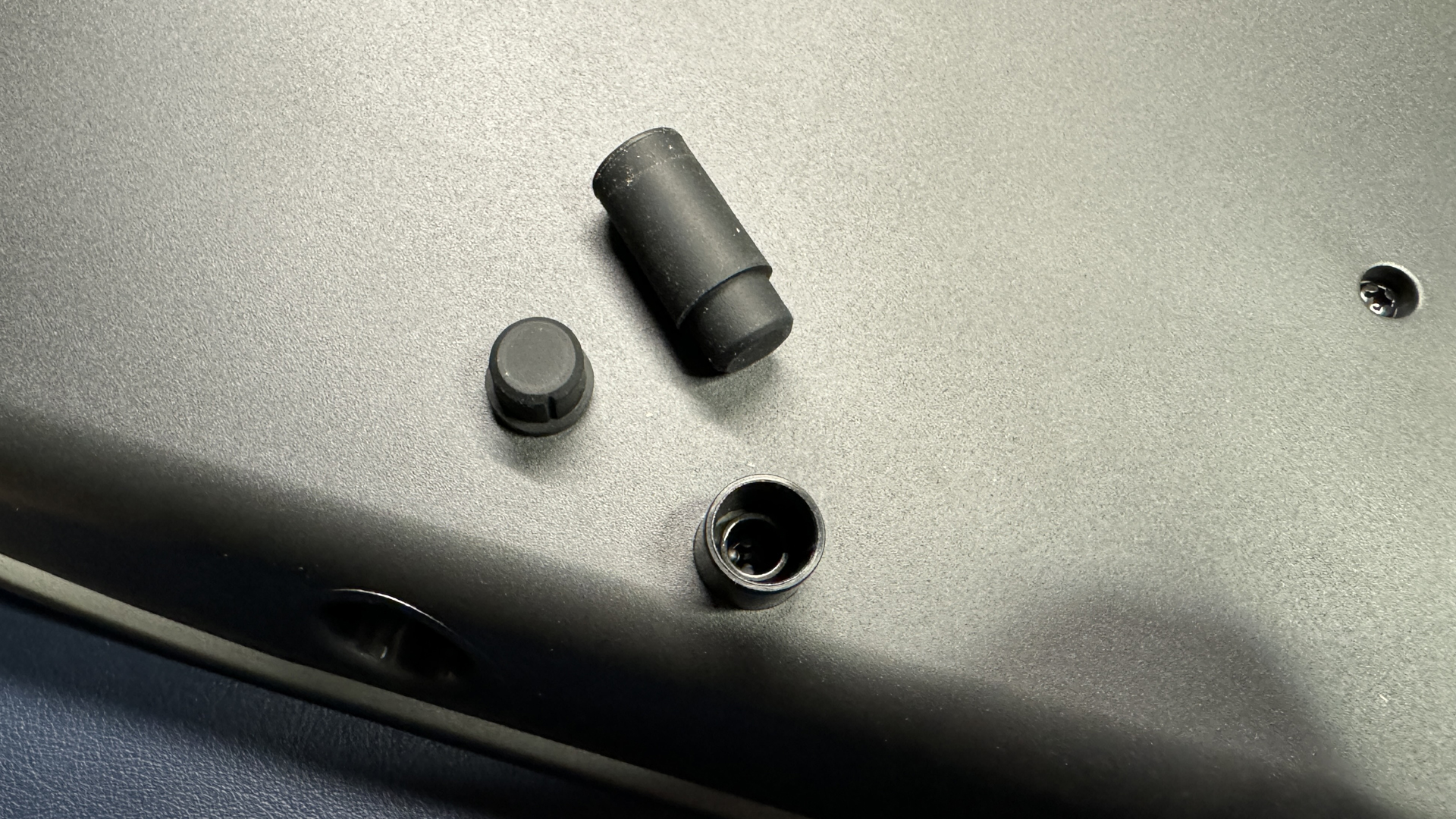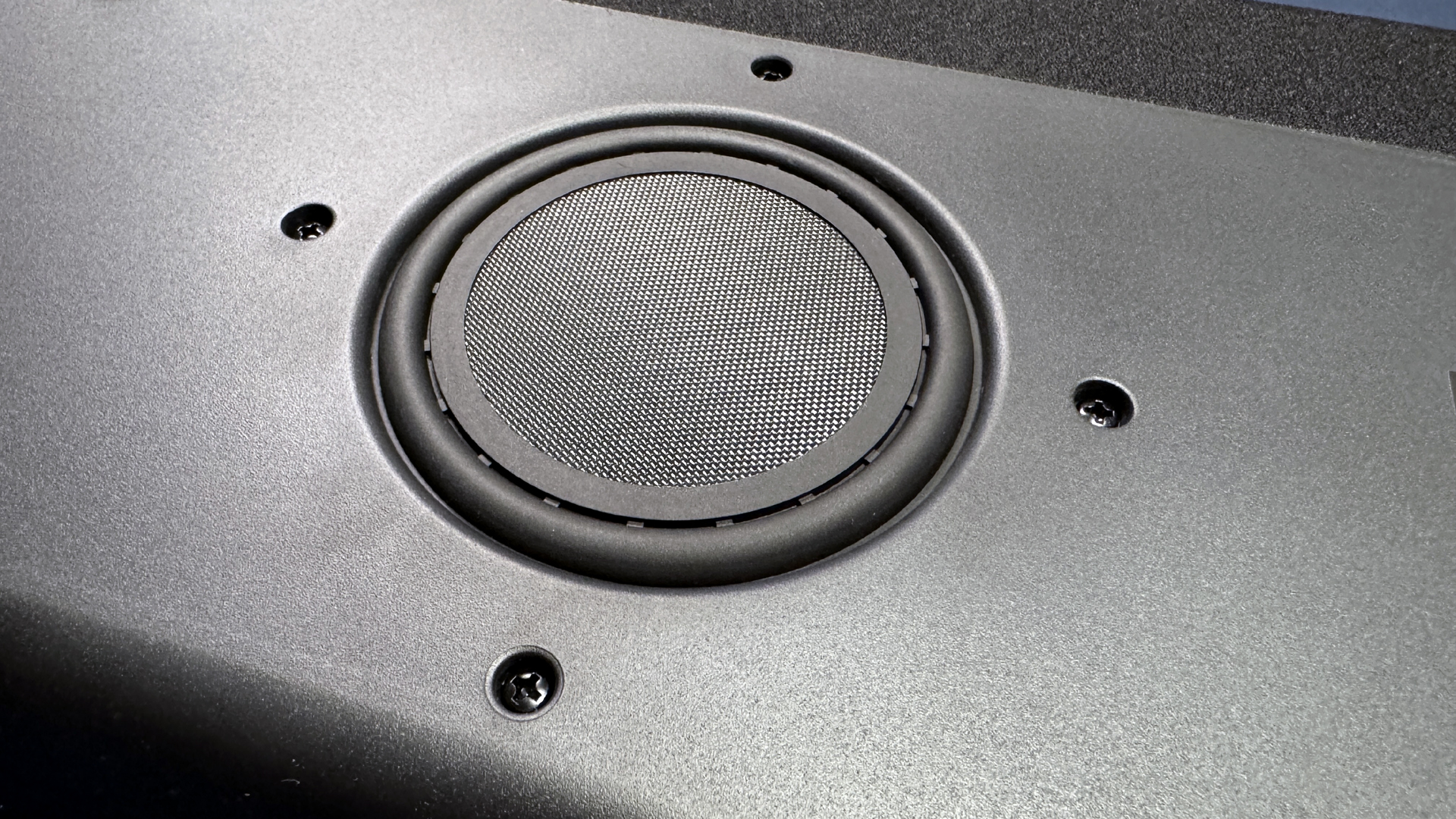Tom's Hardware Verdict
The BlueAnt Soundblade is a sleek, attractive under-monitor soundbar that gets very, very loud (and that's about it).
Pros
- +
Gets very loud
- +
Sleek, attractive design
- +
Dialogue sounds good
Cons
- -
Cannot turn off voice prompts
- -
Not great for music
- -
Kinda pricey, considering
Why you can trust Tom's Hardware
Soundbars are usually aimed at home entertainment systems — not PCs, which is why we don't typically review them. But not everyone has the desk space for a pair of desktop PC speakers (let alone something like a 5.1 surround system), and so a soundbar that sits nicely under your monitor actually makes a lot of sense – assuming it fits under your monitor, of course.
And the BlueAnt Soundblade, at just 2.13 inches high, is designed to do just that. This under-monitor soundbar has a low, flat profile designed to sit over your monitor stand and wow all your friends/colleagues/family members with its sleek, sexy premium looks. It's a 2.1 soundbar with two full-range drivers and an 80mm down-firing subwoofer, and three input options (USB-C, Bluetooth, AUX). And it gets very, very (seriously, it's kind of shocking) loud. It also looks good — it has a fairly attractive faux brushed-metal finish and it comes in several colors (gray, white, light pink, light blue, and light green), and is otherwise just kind of pretty to look at. But are looks and loudness alone worth the $200 retail price?
Design of the Soundblade
The Soundblade is a slim, flat, stylish under-monitor 2.1 soundbar designed to sit over — not under — your monitor stand. It features a textured plastic top that looks a little like brushed aluminum from afar (but definitely looks and feels like plastic from close up), fabric-covered forward-facing stereo drivers, and an 80mm down-firing center subwoofer. It comes in five colors that look like they're designed to match a Samsung Smart Monitor or an Apple iMac: light blue, light green, light pink, white, or charcoal gray (the color of our review unit).
The Soundblade doesn't look like most soundbars. And, let's face it: most soundbars look very, very similar, especially if they're designed for the living room — long, boxy black rectangles with minimal controls, a logo-branded grille, and some sort of mounting hardware. Even soundbars that are aimed at PC users and gamers don't deviate much from this generic design, except to add RGB lighting (a lot of RGB lighting).
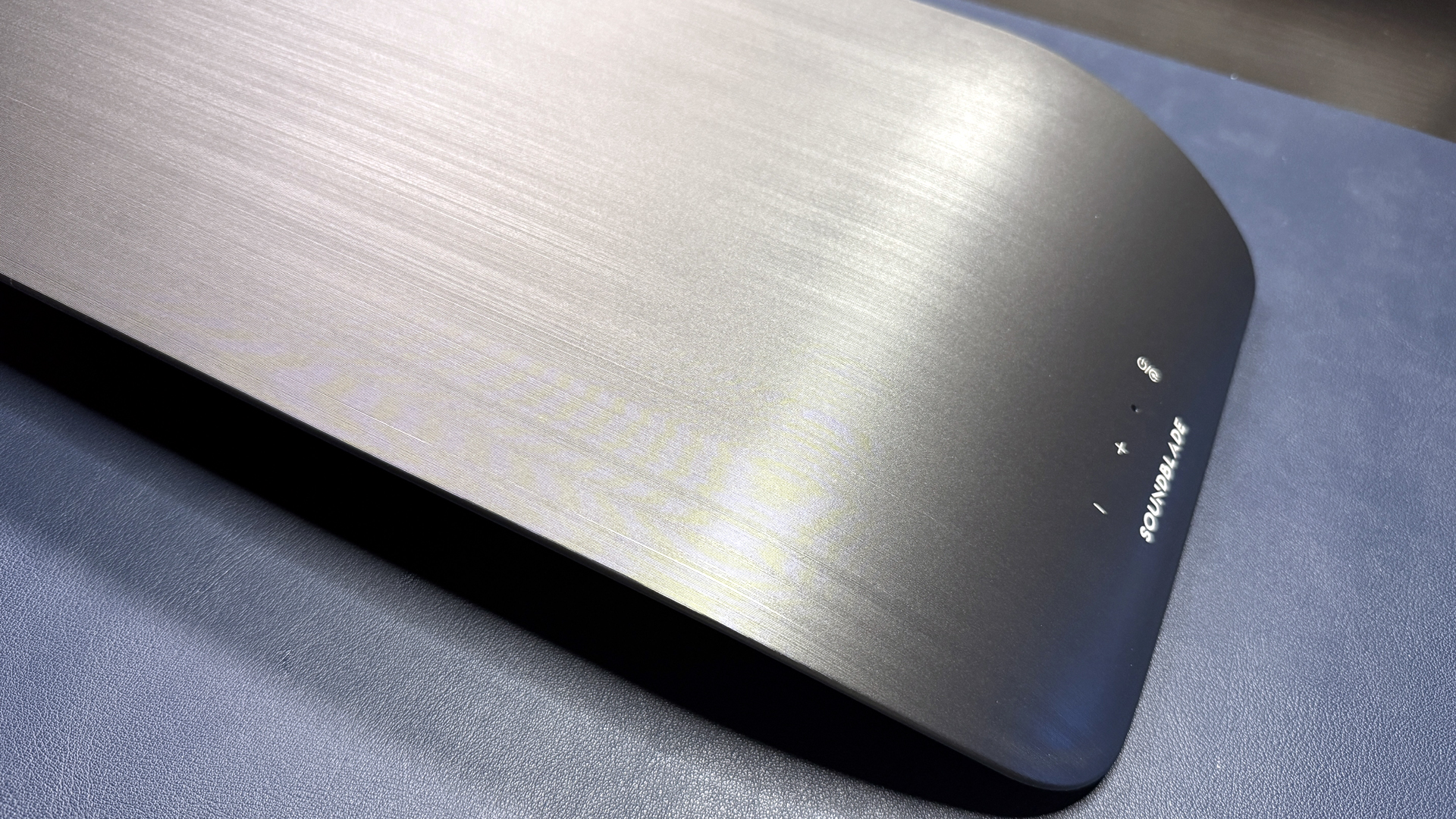
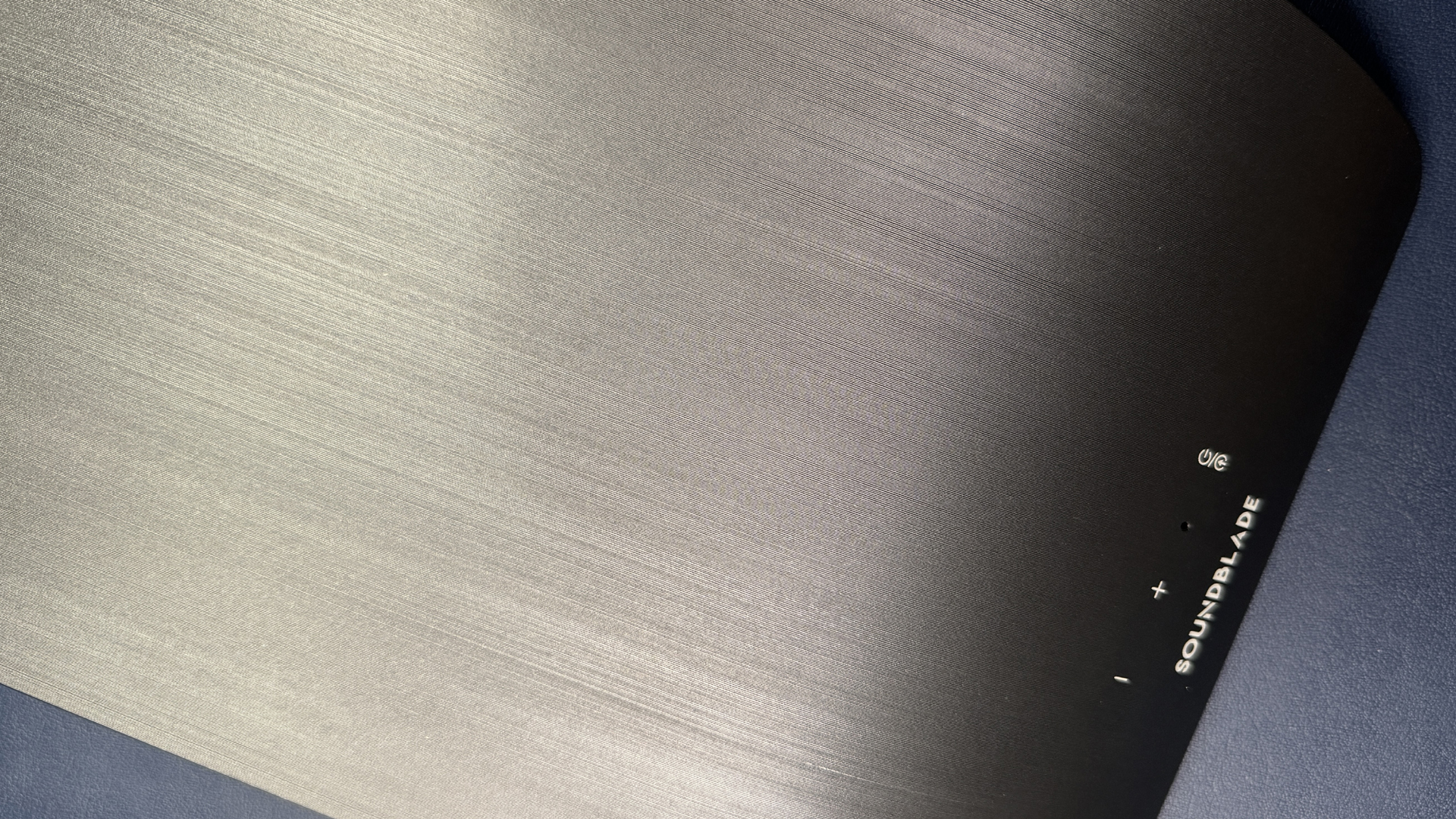

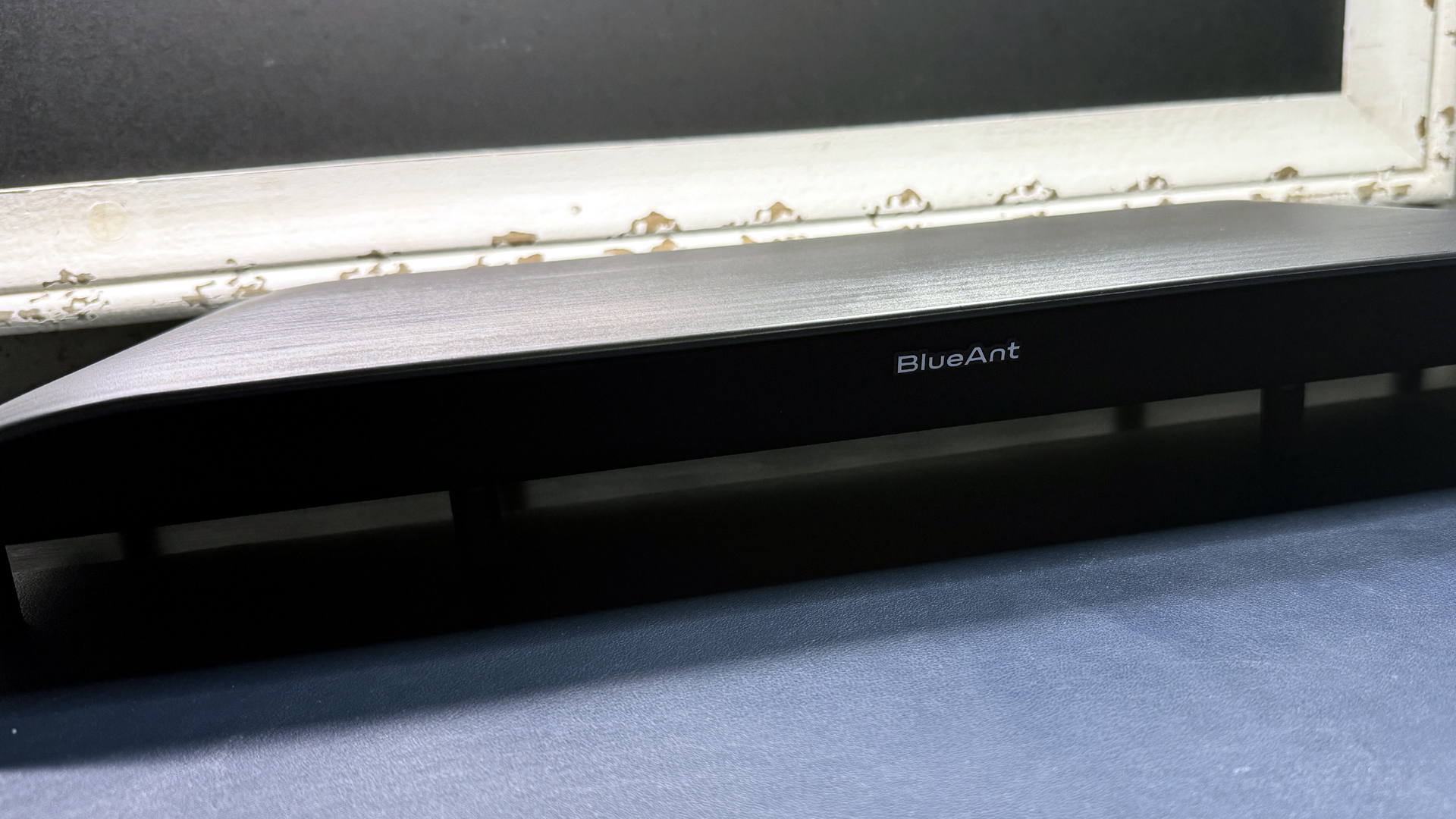
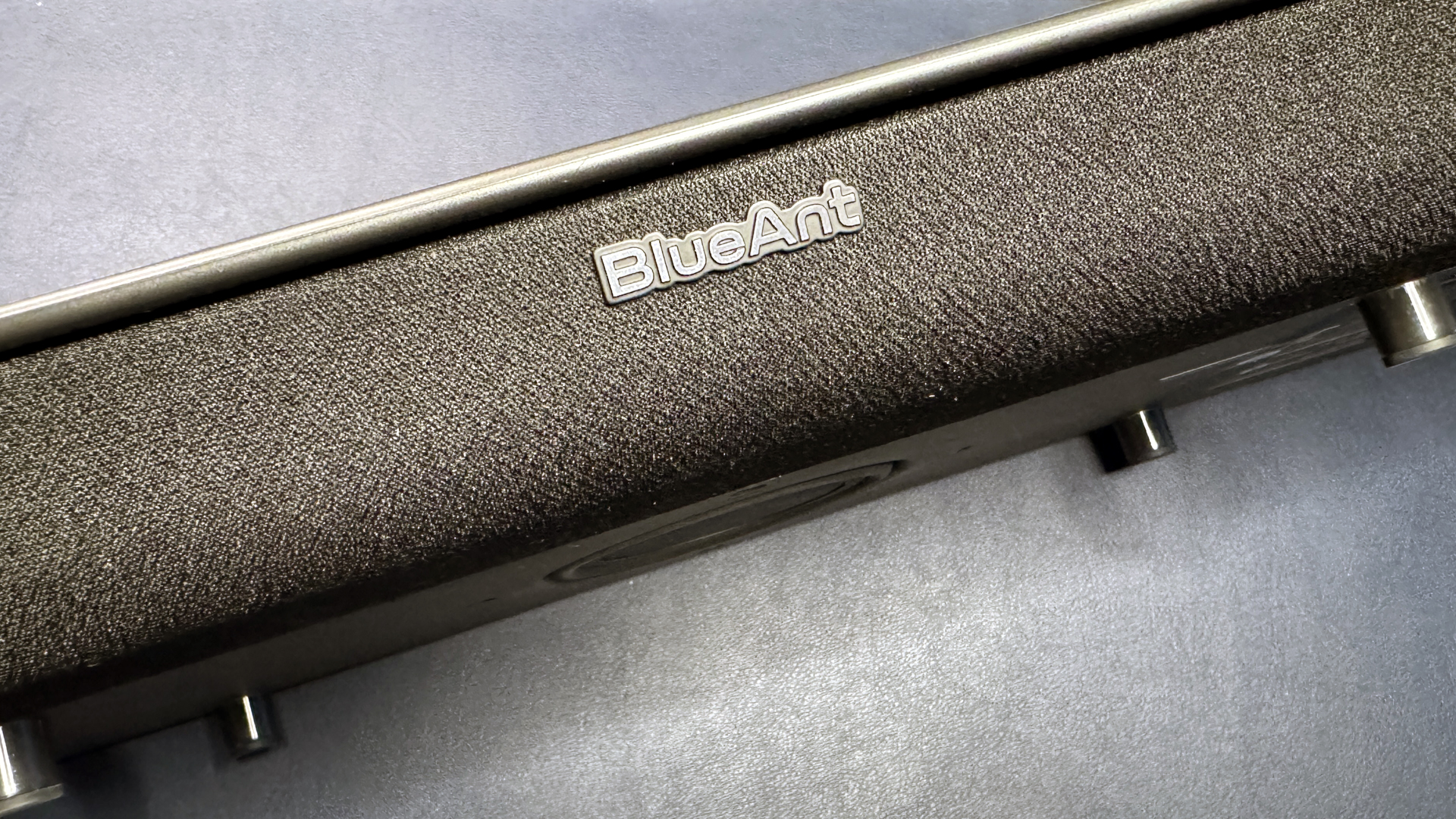
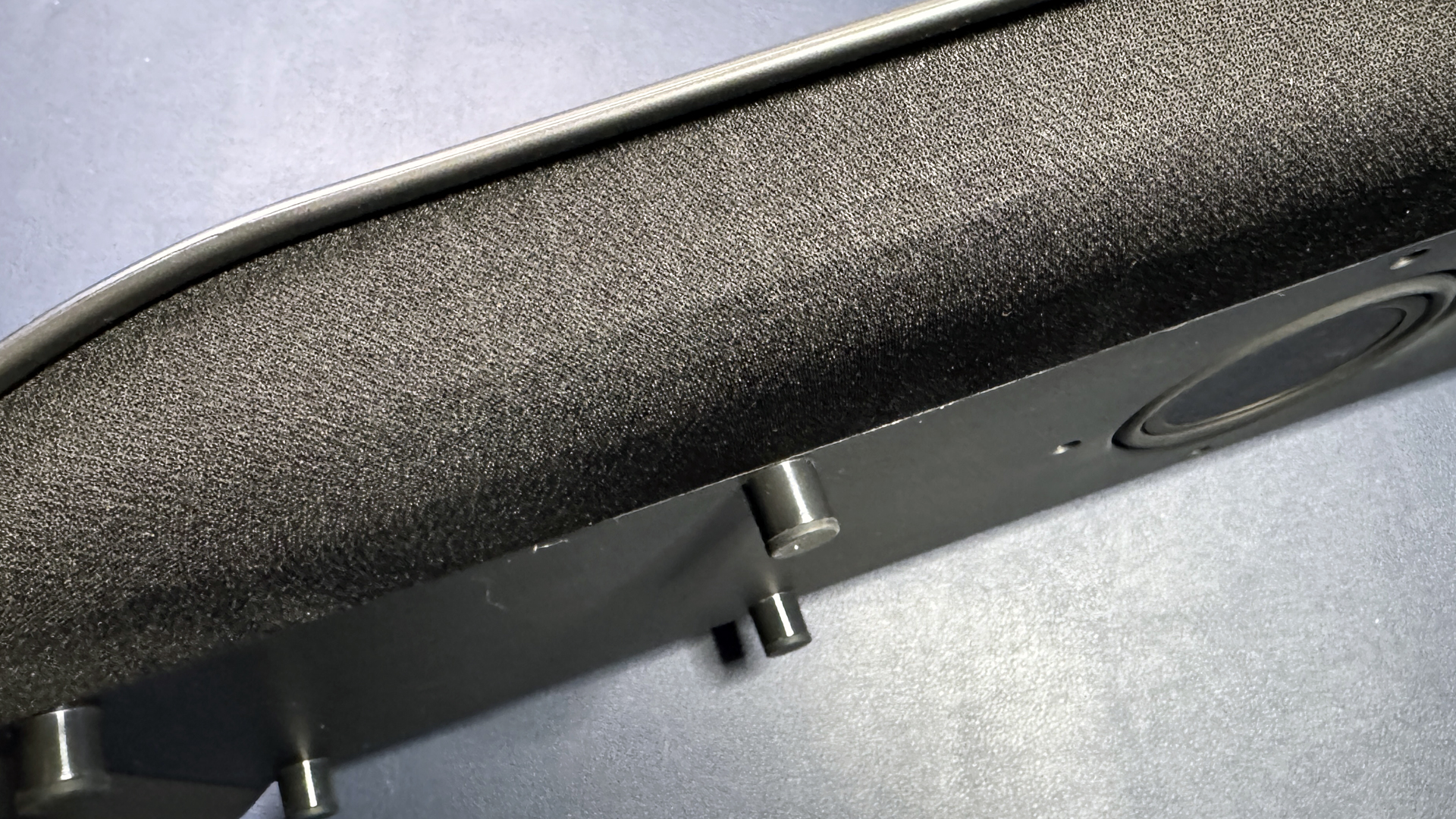
The Soundblade does a decent job of breaking out of that mold, however: It's not a long, black rectangle, it's a flat, wide... shelf? It's 23 inches (584mm) wide, which means it will fit neatly under a 27-inch monitor, and it's 8.58 inches (218mm) deep. It stands 2.13 inches (54mm) tall, which makes it pretty low-profile for a soundbar. For comparison, Razer's Leviathan V2 Pro is similar in length at 23.6 inches (600 mm) wide, but is more than twice the height at 4.5 inches (113.7mm) tall. The Leviathan V2 Pro is significantly shallower, however, measuring just 3.5 inches (90.1mm) deep. But because the Soundblade is designed to sit over your monitor stand, the 8.58-inch depth isn't quite as imposing as it sounds.
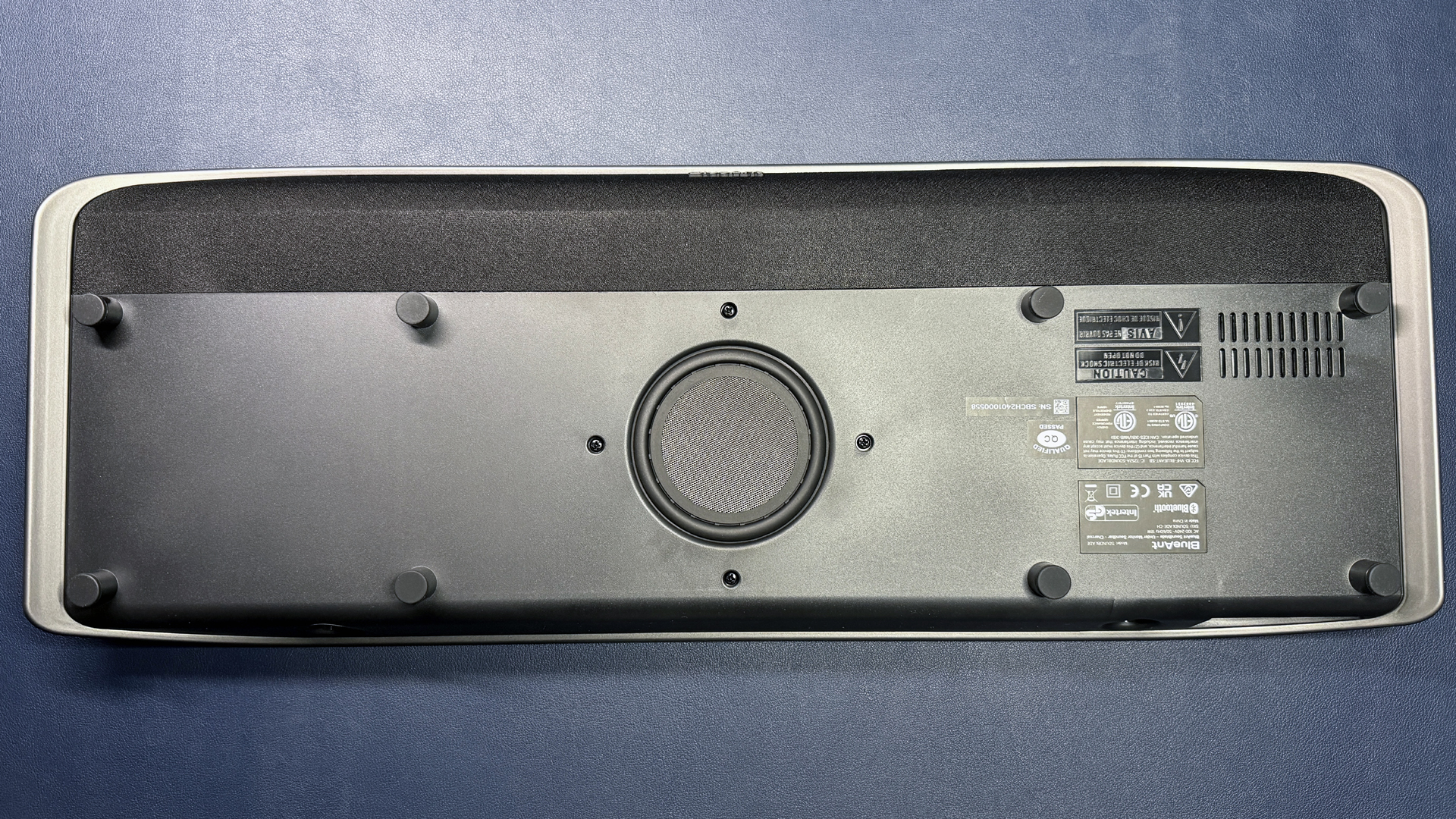
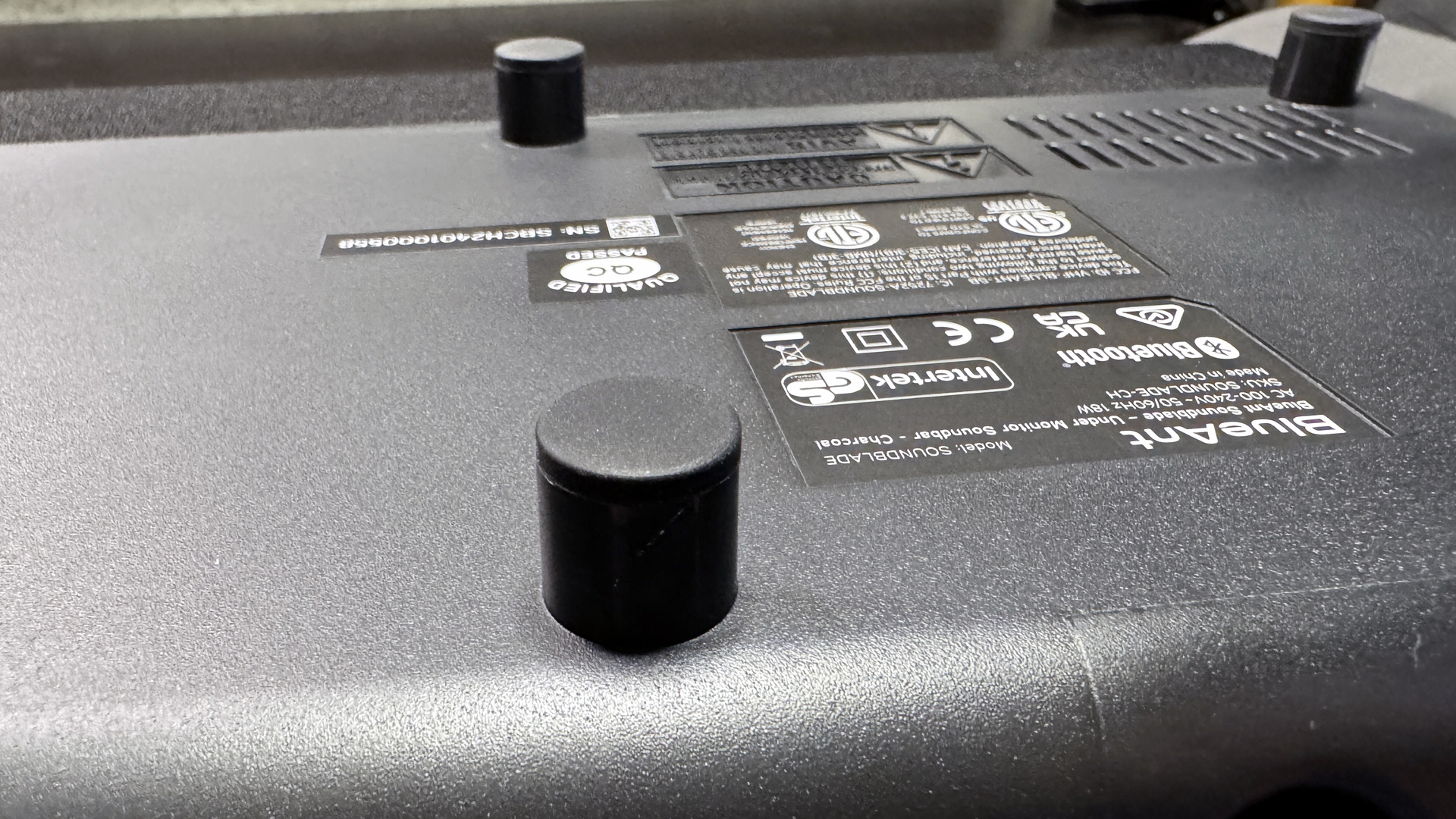
Speaking of the Soundblade's under-monitor (but over-monitor-stand) design, let's get into that: The Soundblade sits on eight short, rubber-tipped legs, which give you about half an inch of clearance between the bottom of the speaker and the desktop. If you happen to have a chunkier monitor stand, don't worry. The Soundblade comes with eight swappable riser feet, which offer an extra 0.75 inches (19mm) of clearance, for a total of 1.25 inches (32mm). The legs are spaced out evenly under the Soundblade, and it seems pretty likely that the soundbar will be able to accommodate most monitor stands. The Soundblade is fairly lightweight at just 3.75 pounds (1.7kg), and as long as you're not using it as a load-bearing shelf, you probably don't need all eight feet to be touching the desktop.
I will now point out that while the Soundblade looks like it could double as a monitor stand, BlueAnt has told me repeatedly that the Soundblade is an under-monitor soundbar and is not designed to be used as a monitor stand/riser. I know — it's the perfect size, shape, and flatness for a monitor stand. That's why I keep asking if I can put a monitor on it, and why BlueAnt has to keep telling me not to do that.
Get Tom's Hardware's best news and in-depth reviews, straight to your inbox.
After having spent some time with the Soundblade, however, I understand why BlueAnt insists it's not a monitor stand: It's very lightweight (it's almost a pound lighter than most generic, budget-priced wood/metal monitor risers you'll find online), and while it feels like it could hold a smaller, lighter task monitor pretty easily, I probably wouldn't trust it with a pricey gaming monitor.
It also feels much less stable if you swap in the riser feet, which are pure rubber and just kind of slip into the slots on the bottom of the soundbar (they slip out as easily as they slip in — I nearly lost a couple of them just from moving the Soundblade between desks).
BlueAnt did confirm that the Soundblade can hold up to 66 pounds (30kg) of weight without affecting performance/sound, however. So you can pile other things on top of it, just not monitors.
Of course, this does make the top feel a little wasted — aesthetics aside. You can't really pile things on top of it because it's supposed to sit under your monitor. You might be able to store a slim keyboard on top of it, but none of my (admittedly, not-so-slim) keyboards could fit on the Soundblade and under my monitor. So it's essentially just a pretty cover for your monitor stand (and also a soundbar), but it would be nice if the top at least had a wireless phone charging pad, or something.

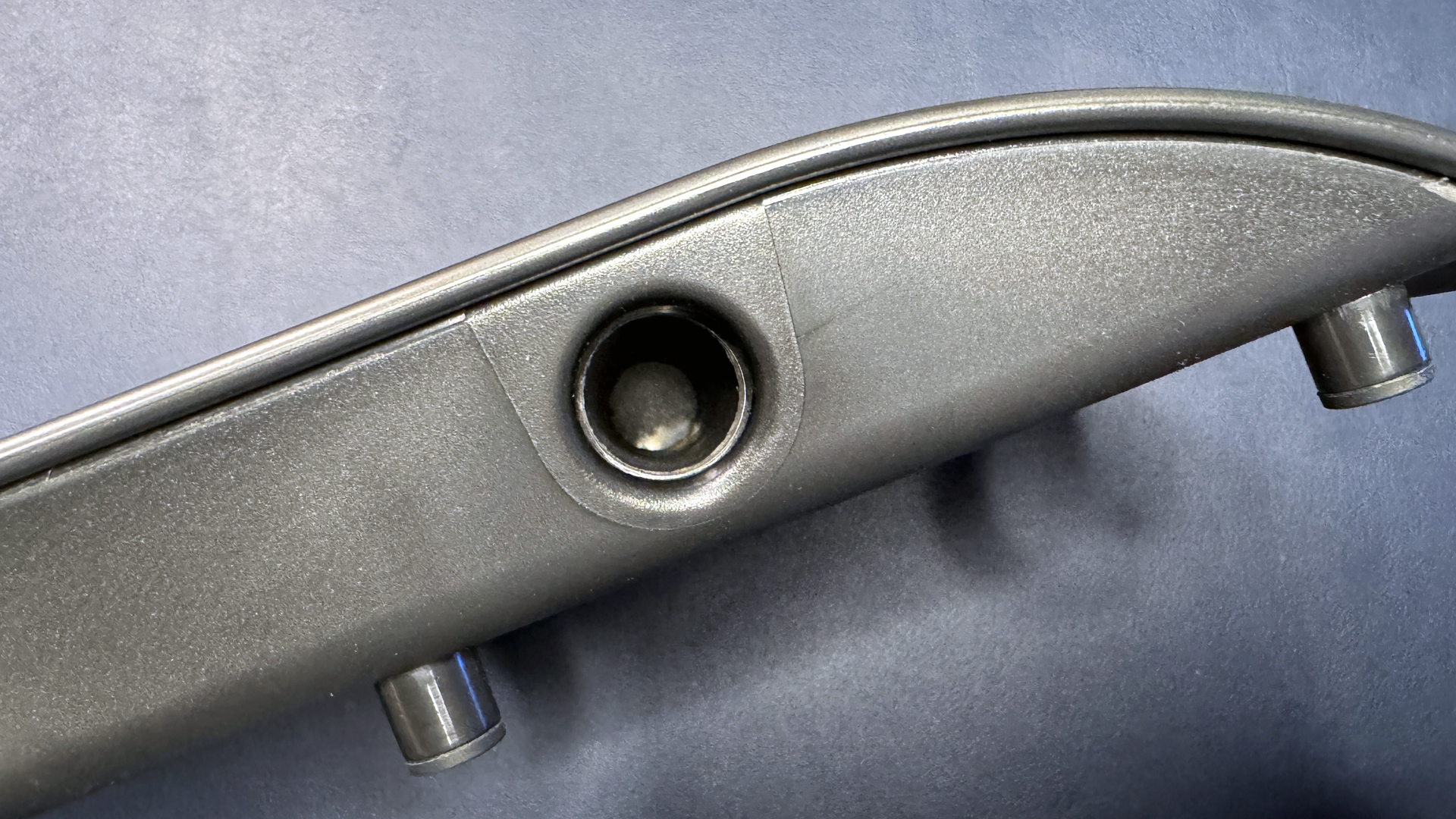
Along the right side of the Soundblade are three touch-sensitive controls: Power/input, volume up, and volume down. They work exactly as described — tapping the power button turns the Soundblade on; tapping it again cycles through the three input options (USB, Bluetooth, AUX).
Each time you change the input, a voice announces the change and the indicator LED changes colors to correspond with the current source (purple for USB, blue for Bluetooth, and green for analog). Tapping and holding the power button turns the Soundblade off, and the volume buttons control the volume. Connections are found on the back right corner: DC-in, USB-C, and 3.5mm AUX.
The Soundblade comes with a handful of cables and accessories in the box. There's a 6.5-foot (2m) power cord, a 3.5-foot (1m) USB-C to USB-C cable, a 3.5-foot (1m) USB-C to USB-A cable, and a 3.5-foot (1m) 3.5mm AUX cable. It also comes with eight rubber riser feet, which are easy to install — they just pop in. Finally, there's a remote (including two AAA batteries), which is where you'll find the majority of the Soundblade's controls. A remote is not my favorite option for a desktop soundbar, but it's not surprising considering soundbars (even desktop soundbars) are often paired with TVs. The Soundblade's remote isn't strictly necessary for operation, but it does let you switch between EQ settings (game, music, and movie), which you can't do on the device.
Minor inconveniences aside, the Soundblade is an attractive soundbar. If your goal is to hide an unattractive monitor stand (and/or a mess of cables at the back of your desk), the Soundblade is a sleek, pretty solution.
Specs
| Speaker Type | Soundbar |
| Driver Type | 2x full-range dual voice coil, neodymium 1x 80mm neodymium subwoofer |
| Power | 120W peak power |
| Inputs | USB-C Bluetooth 5.3 AUX |
| Cables | 6.5-ft power cable 3.5-ft USB-C to USB-C 3.5-ft USB-C to USB-A 3.5-ft 3.5mm AUX |
| Size | 23 x 8.58 x 2.13 inches / 584 x 218 x 54 mm |
| Weight | 3.75lbs / 1.7kg |
| Lighting | None |
| Software | None |
| Features | N/A |
| MSRP / Price at Time of Review | $199.99 |
| Release Date | May 23, 2024 |
Performance of the Soundblade
The Soundblade is a soundbar with a 2.1 configuration, which means it has dual-channel (stereo) sound in the form of two forward-facing dual voice coils, and a bass via a built-in 80mm down-firing subwoofer in the center. BlueAnt doesn't offer much detail on the configuration beyond this, but the company says the Soundblade is designed for a variety of content — including "YouTube videos, Netflix series, immersive gaming sessions, and streaming music."
It also says the Soundblade has "advanced technology for handling complex soundscapes in AI-generated media," whatever that means. When I asked what that meant, a representative offered me this nebulous statement: "In an era where AI shapes the landscape of content creation, producing intricate and sophisticated audiovisual media, the Soundblade stands ready. It brings out the richness and depth in AI-generated content, offering sound quality that truly complements the complexity and intricacies of modern media." Uh... sure.
BlueAnt doesn't provide too many specs aside from the Soundblade's peak power rating (120W), and I can confirm that this soundbar gets surprisingly loud – a little too loud, in fact, considering it's supposed to be a desktop speaker. In our volume testing, the Soundblade hit 88.5dBA at 50% volume, and maxed out at 104.7dBA at maximum volume — which is probably too loud for a speaker that's 20 feet away from you, let alone two. For reference, most of the best PC speakers don't hit 88.5dBA at maximum volume, and they're plenty loud enough for listening to music, watching shows, and gaming at your desk.
Music on the Soundblade sounded... just okay, assuming the volume was cranked way down. Lows and mids were decently strong, especially for the size, and highs were present if a little clipped. The built-in subwoofer can't replace a larger, separate subwoofer (and the Soundblade has no port for plugging in a separate subwoofer), but it delivered sufficiently powerful bass. However, some of the nuance was lost in tracks such as Lorde's Royals or Hans Zimmer's Time.
This was also the case with the midrange: instruments and vocals started to blend together in Enya's Orinoco Flow, and even my all-time favorite mid-heavy Lonely World by K-391 sounded muddled and compressed at its peaks. Highs were a little restrained on the Soundblade, but perhaps that's a good thing as the strings in the beginning of Britney Spears' Toxic were veering toward painfully hissy before being clipped.
Music isn't the Soundblade's forte, but it handled other types of media much better. Movies, shows, and TikTok sounded especially good — voices were dynamic and full, and dialogue was clear and well-separated from any background noise, even when the Soundblade was at lower volumes (which, well, it always was). Games also sounded good, though the Soundblade did have the expected limitations of a 2.1 soundbar. The multi-layered soundscapes of Uncharted 4 and God of War: Ragnarok sounded a little compressed and narrow, but at least dialogue and non-environmental noises (e.g. gunshots, footsteps) were clear.

I didn't test any AI-generated media, because I don't know what that is (unless you count those AI-generated voice captions on TikTok). However, I'm fairly confident that the Soundblade will handle any future AI-generated media as well as it handles any media, and nothing suggests that the "advanced technology for handling complex soundscapes in AI-generated media" is anything other than marketing jargon.
The Soundblade doesn't come with any companion software, but it does offer three basic EQ presets — music, movie, and game — that you can switch between using the remote. Each time you switch EQs, a voice prompt tells you the name of the preset you've switched to. This voice prompt also pops up when you switch between input types, when you power the device on/off, and when you hit max volume.
As of now, this voice prompt can't be disabled and I kind of hate it (I'm just not a big fan of voice prompts — in anything). It definitely doesn't seem like a useful feature for most users — there are only three input sources and three EQ presets, and the only way to switch between EQ presets is by pressing a labeled button on the remote. And I don't know why anyone needs to be told they've hit maximum volume. I'm sure there are cases I can't think of where these voice prompts would be useful and not just annoying, and I think they'd be fine... if they were optional.
Bottom Line
The BlueAnt Soundblade is certainly a unique... -looking soundbar. And it is sleek — there are other low-profile soundbars out there, but most aren't this slim (nor do they look this good). If you're looking for a slim under-monitor soundbar that can handle a variety of tasks including supplying deafeningly loud music for your next house party, the Soundblade is an attractive and versatile option. It's a very good upgrade from cheap laptop speakers or... listening through your monitor.
That said, you're definitely paying a premium for the Soundblade's aesthetic design. It's a good all-around soundbar for when you need, well, sound, but if audio is a priority you'd be better off spending $200 on one of the best gaming headsets. It's also not the most feature-rich soundbar for a PC user — the Creative Sound Blaster Katana SE is pricier (though it's currently on sale for $230), but it offers better audio, a wider range of inputs, gamer-friendly features, and it also slides pretty easily under a monitor.

Sarah Jacobsson Purewal is a senior editor at Tom's Hardware covering peripherals, software, and custom builds. You can find more of her work in PCWorld, Macworld, TechHive, CNET, Gizmodo, Tom's Guide, PC Gamer, Men's Health, Men's Fitness, SHAPE, Cosmopolitan, and just about everywhere else.
-
MiniITXEconomy "Cannot turn off voice prompts," well I'm out. I bought a soundbar from Walmart's Onn brand and I'm sick to death of its voice prompts every time I turn it on, or off, or max out the volume! On my next PC build, the speakers are going to be the first thing I source, and then build around that!Reply -
purposelycryptic Maybe I just haven't messed with PC audio in too long (I play PC games on my living room TV, so they get the advantage of the 7.2.4 home theater setup), but the lack of optical input or HDMI passthrough feel weird to me.Reply
Getting a soundbar only to degrade your sound quality by using Bluetooth seems counterintuitive, AUX is limited to stereo without an LFE channel, so I guess the main idea is to use USB, but I would much rather not use up a USB port for audio if I don't have to, and I can't really see a reason for why you would here. Or have motherboards stopped having optical output since I last bought one?


